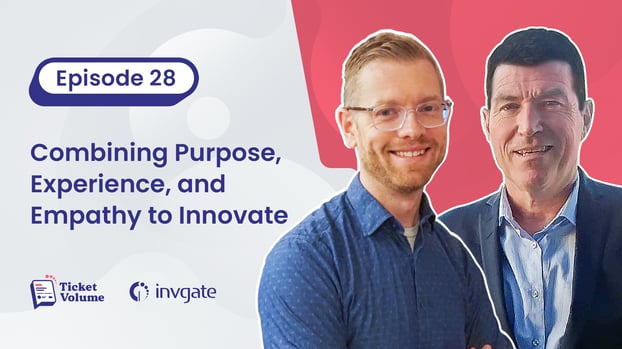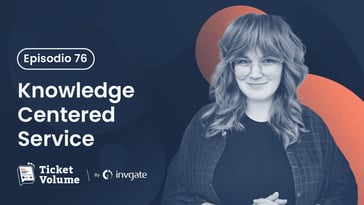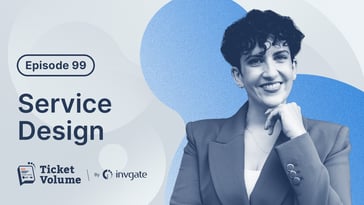Innovation consultants work with senior stakeholders and leadership to understand organizational problems and explore potential solutions. This is necessary because technology is tangible, but people and process aspects can be nebulous.
On the 28th Episode of Ticket Volume, our IT podcast, Lorn Campbell highlighted the significance of understanding the company's purpose, utilizing controlled experiences and fostering innovative change through empathy. He then discussed his process of conducting interviews and simulations and so much more.
With a career in the consultancy field spanning since 1995, Lorn Campbell brings a wealth of experience to his role as an Innovation Consultant at CDW. His expertise lies in assisting customers in enhancing their IT systems, employee workflows, and customer experiences. Lorn excels at guiding the successful delivery of intricate projects by leveraging immersive experiences.
We highly recommend giving the entire episode a listen to fully immerse yourself in their engaging conversation. Now you can also register for our monthly live recordings! This way, you could actively participate and get your questions answered in real time. It's a fantastic opportunity to engage with the content on a whole new level.

Providing context and experience for innovating change
Innovation consultants like Campbell aim to expand people's understanding of the services or products they need to incorporate into their applications. He explained that different levels of that understanding exist among leadership, management, and operational teams within organizations, so IT leaders must delve into client perceptions and needs before moving toward any solutions or providing assistance.
|
|
"There are different levels of understanding of where people are in their journey. (...) So one of the things that we do is to try to find out what they think they need and what they don't know and don't know. (...) We try a few little approaches to find where that is because that's key before we start moving towards any solutions." Lorn Campbell |
For Beran, that sounded a lot like going to therapy. But, it’s pretty much it is about how to facilitate conversations with clients to align perceptions and analyze their context. One way to do it is to use metaphors to test the client’s knowledge and open up wider discussions. This way consultants help them see the bigger picture and provide insights into why certain approaches may or may not work.
Nevertheless, business urgency often leads to a focus on technology, more than on alignment with process and business needs. Campbell illustrated how this approach can lead to designing a jail, because some bosses close to technology may not fully grasp the importance of aligning technology. And that is when true innovative change happens.
Overall, these are some of the hurdles and strategies you can find along the way to overcome these misunderstandings, according to Campbell:
Connecting business outcomes to DevOps tools and processes
IT leaders struggle to connect business outcomes to the underlying tools and processes in CI/CD and DevOps. This challenge lies in understanding the atomic structure of what is happening and connecting the macro (business purpose) with the micro (individual tools and processes).
Campbell explained this plain and simple: Desired states define how things should be, similar to Formula One pit crews who know precisely what to do when to do it, and how to do it. Operational teams aim to shave off microseconds from their processes, just like a tight-knit team such as a military unit or a small finance or engineering team. As operations expand beyond tight-knit teams, challenges arise in maintaining control and connection. Examples include financing, engineering, and other areas where people and processing technology are involved.
But, the lack of effective storytelling is often the reason why things don't work in CI/CD and DevOps.
The key is to find the reason why a train jumps off the track to prevent it from happening. To make sense of this, Campbell pointed out that storytelling plays a crucial role in connecting people with purpose. Broken storytelling leads to a lack of adherence to processes and a disengaged workforce.
|
|
"All of us are purpose-led (...) and having that story helps us connect to that purpose all the way through and if that is broken that's when you start getting people just following the numbers, calling it in, just showing up for a job and so forth. (...) Even if the process is being created and it doesn't quite make sense you've got an option of either doing it and commenting on it or just skipping it; and most people just skip it if they're not connected with the purpose." Lorn Campbell |
Finding purpose and connection to work
Campbell shared his personal experience working for a medical device manufacturer. Witnessing how their products saved lives made them take their job more seriously. Connecting with the purpose behind their work inspired them to do better.
However, not all sectors fully appreciate or balance the impact of their work. And for that, you have to understand the market needs and adapt accordingly. Just as different industries have different key performance indicators (KPIs), it can be challenging for some individuals or organizations to accept sustainability as an important KPI in certain industries like oil.
Here is where value mapping makes the most sense for innovating change. Campbell emphasizes the significance of business value mapping in determining an organization's position in the market as a way to get the macro story. They need to lift their heads and see the bigger picture beyond the constant flow between supply and demand.
According to him, the problem is they often get caught up in day-to-day operations, making it difficult to focus on strategic thinking. So he explained the IT industry could benefit from aligning its leadership with simulations, which dates back to MIT's Sloan School of Business in the 1960s.
Incorporating gamification
Gamification was used to create urgency in the sales cycle. Now, gamification is a tool for practical discussions and to bridge the gap between nebulous concepts and practical implementation.
For change managers, this is the way to go when building simulations. Campbell thinks it’s effective in bringing together disparate groups of people with different levels of understanding in ITSM, as well as allowing participants to experience the practicalities of a maturing system.
It helps to understand how processes work when real traffic is run through them. Participants gain confidence and trust in the system through this safe zone experience. Then IT leaders can apply it to real-world scenarios.
For Campbell, it's as clear as day why this makes sense: simulations allow for quick focus from macro to micro levels and vice versa. Active case studies can be examined closely to learn about process behavior, technology impact, financial implications, and overall experience. This zooming capability aids in analyzing large-scale impacts on a process or organization's performance.
Simulation-based learning does not aim to teach but rather guides participants through discovery. The design of simulations facilitates self-learning experiences for individuals. Facilitators play a listening role during simulations, allowing participants to learn at their own pace. It provides an opportunity to explore the processes and leadership aspects of building apps, products, or services.
Bottom line
This is just a summary of Ticket Volume's episode featuring Lorn Campbell, but there's a lot more to discover in the recording. Be sure to listen to the full conversation with Matt Beran to delve deeper into the world of innovating change while also answering "What does it mean in a practical sense when contact center people are not really caring about answering the phone?".
You can find the full episode on popular platforms like Apple Podcasts, Spotify, YouTube, or any other podcast platform you prefer. Remember to subscribe if you're interested in joining the monthly live recordings!















